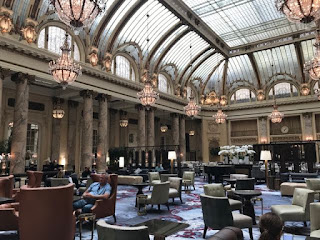I wanted to do a redo of their earthquake reenactment room. I'd been there with him before. I didn't
 |
| Earthquake Simulation Room Cal Academy |
So I wanted to go back and compare it to our recent quake. Well, it did shake about as much as the quake we were in. But it doesn't give you a sense of a real earthquake. It's a small room like in a house, but there are hand rails to hold onto all around. You know what's going to happen. There are other people in the room with you. It shook back and forth mimicking the 1989 quake, and then the 1906 quake.
But this was more like the entertainment of an amusement park ride. You go there to experience it. It is different when it arrives announced in your own house or office or elsewhere in your environment and starts up and you have no idea how much bigger it's going to get or how long it's going to last and whether your house is going to hold together.
So, yes, physically, you get a sense of an earthquake in this room. But psychically, not at all. We went on to watch the Foucault Pendulum knock over a couple of pegs and then to the rain forest.

There's the several story netted rainforest with lots of tropical butterflies and there are smaller exhibits along the path that winds up to the top. Like the one that held this bright green lizard.
Then at the top, you take an elevator down and you end up below the water at the bottom of the rainforest.

It was great to be on an adventure with my grandson, just the two of us. And there were plenty of other grandparent/grand child visitors there too.
Today, after dropping him off at his pre-school we stopped at a great little hardware store in Japan Town, but they didn't have the Chinese picture hanger I was looking for. But they have so many interesting things.

A bit later we went for lunch with PK who was in my Peace Corps group. In fact he was the closest volunteer to my town. Except that there were no roads between his town and mine. You had to wander by motorcycle through the rice paddies to connect.
We passed this bear gargoyle on the way to meeting him and his partner.
P was in the hotel business in San Francisco for many years so he took us to a couple places we never would have found. First, to eat at Belden Place.
From Wikipedia
"Belden Place itself is a one-lane, one block long street running south from Pine Street to Bush Street, parallel to and in between Montgomery and Kearny streets, immediately south of the Bank of America tower. It is roughly between Chinatown and the Financial District.
In 1990, restaurateurs Olivier Azancot and Eric Klein opened Cafe Bastille, the mainstay that set the modern tone for the area. The French, Italian, and Catalan establishments are popular with locals, tourists, and office workers, and are generally considered on par with the city's best casual full-service European restaurants.[3] Notable restaurants in the alley itself include Sam's Grill, Cafe Bastille, Cafe Tiramisu, Plouf, B44, Belden Taverna, and Brindisi Cucina di Mare. Nearby are Café de la Presse (though modest and unassuming, a favorite hangout of the city's political and social elite) and Le Central. Also nearby are the Alliance Française, the French consulate, and the Notre-Dame-des-Victoires Church (where mass is still celebrated in French) and an affiliated elementary school. In the vicinity are several other restaurants, cafes, hotels and other French-related institutions along Bush Street and Claude Lane, another nearby alley.[2]"

In summer the canopies are gone, but it was a nice day and we sat under the canopy and had a delicious Italian lunch at Tiramisu. (After the yellow tarps.)
Then to see the courtyard at the Palace Hotel.
From the Garden Court Restaurant website:
"When the Palace Hotel opened its doors in 1875, the Garden Court was the carriage entrance to this grand hotel. A parade of famous guests visited San Francisco's Palace and stood in awe of its magnificence.P and I first met at Peace Corps training in DeKalb, Illinois in 1966. We don't see each other often, but it's great when we do.
In 1906, following the earthquake, the Palace closed its doors for the first restoration. Three years later, the carriage entrance was transformed and The Garden Court was unveiled. Since its debut in 1909, The Garden Court has been recognized as one of the world's most beautiful public spaces
With its incredible architecture, dome stained glass ceiling and Austrian crystal chandeliers, The Garden Court became the site for some of the nation's most prestigious events. In 1919, President Woodrow Wilson hosted two luncheons in support of the Versailles Treaty which ended World War I. In 1945, the official banquet honoring the opening session of the United Nations was held in The Garden Court."








































